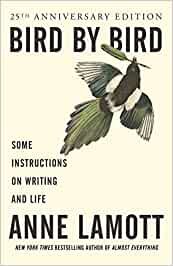5 Books To Read In 2020 That Will Instantly Improve Your Writing
I recently asked myself, “what was the single most important book (on writing) that I have read?”
I couldn’t pick just one.
Here are the five books on writing that have transformed the way I approach fiction and have made me a better writer.
Dialogue by Robert McKee
Key takeaway: Know thy character
Darth Vader: “No, I am your father.”
Jerry Seinfeld: “Not that there’s anything wrong with that.”
Rick Blaine: “Of all the gin joints in all the towns in all the world, she walks into mine.”
The dialogue quoted above are perennial quotes that do something more for the characters who said it than simply express information. They’ve pervaded our society at such a level that almost anyone you ask could identify the origin of the quotes.
But they also do more than just express information. They tell us more about who those characters are.
That’s what good dialogue does. It reveals information about the character, through words only that character could say.
And the only way to know what your character would say is to know who your character is. This led me down a rabbit hole of asking myself questions about characters, and how to know them.
It also led me to the conclusion that good novels are about character first, which completely transformed how I look at novels and fiction.
How To Write Compelling Fictional Characters — Notes On Characterization
When I think of a great fictional character, what immediately comes to mind is Gyp Rosetti of Boardwalk Empire, played…
medium.com
Anne Lamott’s Bird by Bird
The key takeaway: Allow yourself to suck.
For a writer just starting out, this lesson is incredibly important. It is, perhaps, the most important lesson you can learn as a *new* writer, or anyone in any creative field.
Your ability to make great work is not proportional to your ability to recognize great work.
Your ego starts to go wild, crying out for attention, and bashing its head against the wall, yelling obscenities and saying “you’re terrible! you’re awful! you stink!” all the while you’re trying not to be any of those things.
Your ego is the enemy.
Just sit down and do the work and your ability to make great work will eventually, one day, hopefully, if you’re lucky, catch up.
I’m reminded of a video by Ira Gass of “This American Life,” who probably put it better than I ever could (there’s that ego).
John Gardner’s The Art of Fiction: Notes on Craft for Young Writers
The key takeaway: You’re creating a movie in someone’s head — make it come alive with detail.
This book may have had the biggest direct impact on my writing.
Here’s how Gardner puts it:
“…vivid detail is the life blood of fiction. … The reader is regularly presented with proofs — in the form of closely observed details — that what is said to be happening is really happening.”
That is, when a floor board creaks for no apparent reason, when the wind whistles, and the author does up his sweater, the one with three buttons, not four, whose threads have worn through at the elbows, it’s because they’re helping you imagine the story in your mind. Guiding you through details, small puzzle pieces, that you put together to form a picture, a running movie.
It is not because the writer is verbose or likes to hear himself speak (though, this writer may sometimes likes exactly that), or because he wishes to bore you, but precisely because he does not want to bore you, that those added details, those ostensibly pointless facts of a story, are there to make that film-engine in your brain run.
Rhetorical Grammar: Grammatical Choices, Rhetorical Effects by Martha Kolln and Loretta Gray
Key takeaway: A single comma should never separate the subject and verb of the sentence.
But more generally, the many functions of grammar are the tools in your writer’s toolbox. Knowing how to structure a sentence, how to use a comma, when to use dashes, how semi-colons work, what is a subject and what is a predicate, gives you a greater command over achieving the writerly affect that you wish to achieve.
Not only that, but knowing the rules of grammar also gives you carte blanche to break them.
It is my sincere belief that you can only break grammar’s rules if you first understand them. Then you have permission, because you understand the affect that you are having when you break them.
This specific book, which I bought for a grammar class nearly 6 years ago, was the best breakdown of the grammar rules that I have yet to read.
It beat out books like Eats, Shoots and Leaves and The Elements of Style because it was more effective in teaching me the functions and purpose of grammar, instead of only teaching me the rules. And I think understanding is the best way to learn anything.
Self-Editing for Fiction Writers by Renni Browne & Dave King
Key takeaway: Breaking down editing into parts. Look for x, fix x, then look for y, fix y.
To be completely honest, breaking down this book into a single key takeaway was extremely difficult.
This book is so full of wise nuggets that were so valuable to me while I wrote my first novel that it inspired me to make my own 56-point editing checklist.
As I come to the end of my third draft of my second novel, I plan to read it again, as I will at the end of every novel.
But as I said in my key takeaway, they go through 12 different sections of editing, what to look for, and what to change. As they say in the book “Get out your highlighter and look for X.”
And breaking down editing into a process of bite-sized, singular fixes, made editing a manageable and digestible feat.
For example, while you’re reading or writing your novel, create a list of words that you think you overuse, use wrongly, or don’t like.
Some of mine include words like very, really, that, like, suddenly, eyes, brows, just, began, down, character names, ‘ly’ words, precipice, week-worn, but just, sip, smile, for a moment, great, good, drink, and so on.
Then use “Command / Control F” (if you’re writing on a computer) and search our those words and fix them.
And that’s it for my top 5 books on writing. Hopefully 2020 is filled with a brand new list.
What do you recommend?
BONUS BOOK - My novel, It’s A Long Way Down, is the book to read in 2020!
It's A Long Way Down tells the story of David Emmeret Smith, a successful actor who, on the cusp of the biggest night of his life, acts on one impulsive decision after another, beginning a downward spiral that threatens everything he holds dear. What follows from this is a hedonist’s love affair with drugs, depravity and destruction and the realization that it wasn’t so far down after all.
"A good addict isn’t built overnight.
He isn’t built in a week, or two weeks, or a month.
An addict, much like a well-deserved discipline, a martial art, a painting, or a poem, takes time to build—and a fair bit of money—and David had as much of either of those as any junkie ever had.
However, within him still remained a last quality that, in order to be a full-fledged card carrying member of team tar, to wear, not his heart on his sleeve, but junk in his veins, had to be expunged: his pride.
A junkie’s pride—once the junk has embedded itself into the cellular structure, once it has forced itself into every nodule and nook and nether region, once it is a necessary part of the human biome, a cellular symbiosis, a partnership baked in the intertwining facets of pleasure and pain, when you would do anything, everything, for one more taste, one stretched dollar, a soul for a spoon, a prick for a prick—is always the last to go, the final stage in a metamorphosis that no man should undertake.
David, naive to the state of his body’s new chemical makeup, had to learn this the hard way. He had, as the proud do, decided that he wasn’t a man who bent the knee to any drug. He had to show himself that every decision he made was a conscious one, that he had a will of his own, was a man with agency.
But, sooner or later, pride leaves the body, and what is left is the junk and a man must come to terms with a solitary truth: knees were made to bend."
Find out in the debut novel by Ian Canon.
>> Download The Self-Publisher’s 56 Point Editing Checklist: How To Go Straight To Print. <<









